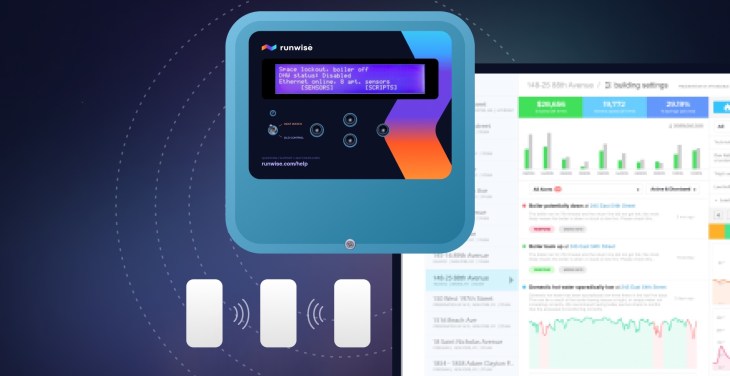In the U.S., around 13% of greenhouse gases are spewed out of commercial and residential buildings. You’d be forgiven for scratching your head and asking why. If you tour a typical New York building, you’ll often find that the tech that runs deep in the underbellies of the brick-clad behemoths looks like the 1960s and smells even worse. Runwise is already in 4,000-ish buildings, and today announced it raised $11 million to put its tech into many thousand more. The company has a winning win/win combination of saving landlords money while giving planet earth a break in the process.
Runwise’s selling point is taking ancient tech that often operates on on/off switches or timers rather than sensors, and sprinkling enough technology on top to ensure that buildings aren’t heating more than they need to. The company has developed wireless sensors that operate on batteries with a 10-year battery life, and a controller computer that takes charge over the building’s boilers and heating. It claims that the average time to recuperate the cost of the install (in the form of reduced heating bills) is around nine months.
“Five or six years ago nobody gave a shit about the environment, and we’d be like, ‘but it’ll have a huge impact!’. They’d ask us about the bottom line, and suddenly we’d have a conversation going,” Lee Hoffman, COO and co-founder of Runwise explains. “Our vision long term is if you run buildings better you can change the carbon profile and affordability of pretty much every city out there. That’s really our goal; there are 12 million buildings in the United States. We’re in 4,000 today, there’s really no reason we shouldn’t be in all of them.”
The company has been bootstrapping for a decade, with some impressive results: its tech is already available in buildings owned by some of the largest real estate operators in the country, including Related, Blackstone, Lefrak, Equity Residential, Douglas Elliman and Fairstead. Runwise claims more than 300,000 people live and work in the 4,000 or so buildings it operates. It decided it’s time to kick the company into a phase of hyper growth. It raised $11 million from Initialized Capital, Susa Ventures and Notation Capital, with participation from NextView Ventures and several angels.
“Most buildings in New York — and pretty much the entire country and the world — run on controls that were designed in the 1960s and 70s, made by a handful of companies. If you go into a brand-new Bank of America high-rise glass tower, it has a control box that has a fancy digital display, and it’s literally inside the same control from 1960s or 70s,” Hoffman explains, and gets a little animated in his incredulity. “It runs what’s called an outdoor reset, which is basically a static Excel table. If it’s heating this many minutes, turn on the heat. If this is the temperature outside, do this. It has no idea what’s going on inside the building. It’s all hardcoded. It’s completely bonkers. And this is controlling millions of dollars of energy spend in almost every building!”
